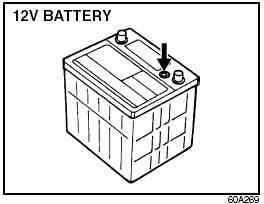Jump Starting Instructions

WARNING:
• Never attempt to jump start your
vehicle if the battery appears to be
frozen. Batteries in this condition
may explode or rupture if jump
starting is attempted.
• When making jumper cable connections,
be certain that your
hands and the jumper cables
remain clear from pulleys, belts or
fans.
• Batteries produce flammable hydrogen gas. Keep flames and sparks away from the battery or an explosion may occur. Never smoke when working near the battery.
• If the booster battery you use for jump starting is installed in another vehicle, make sure the two vehicles are not touching each other.
• If your battery discharges repeatedly, for no apparent reason, have your vehicle inspected by an authorized SUZUKI dealer.
• To avoid harm to yourself or damage to your vehicle or battery, follow the jump starting instructions below precisely and in order. If you are in doubt, call for qualified road service.
CAUTION:
Your vehicle should not be started by
pushing or towing. This starting
method could result in permanent
damage to the catalytic converter.
Use jumper cables to start a vehicle with a weak or run-down battery.
When jump starting your vehicle, use the following procedure:

1) Use only a 12 volt battery to jump start your vehicle. Position the good 12V battery close to your vehicle so that the jumper cables will reach both batteries.
When using a battery installed on another vehicle, DO NOT LET THE VEHICLES TOUCH. Set the parking brakes fully on both vehicles.
2) Turn off all vehicle accessories, except those necessary for safety reasons (for example, headlights or hazard lights).

3) Make jumper cable connections as follows: 1. Connect one end of the first jumper cable to the positive (+) terminal of the discharged battery (1).
2. Connect the other end to the positive (+) terminal of the booster battery (2).
3. Connect one end of the second jumper cable to the negative (–) terminal of the booster battery (2).
4. Make the final connection to an unpainted, heavy metal part (i.e.
engine hook (3)) of the engine of the vehicle with the discharged battery (1).

WARNING:
Never connect the jumper cable
directly to the negative (–) terminal of
the discharged battery, or an explosion
may occur.
4) If the booster battery you are using is installed on another vehicle, start the engine of the vehicle with the booster battery. Run the engine at moderate speed.
5) Start the engine of the vehicle with the discharged battery.
6) Remove the jumper cables in the exact reverse order in which you connected them.
See also:
Jacking Instructions
Jacking Instructions
1) Place the vehicle on level, hard ground.
2) Set the parking brake firmly and shift
into “P” (Park) if your vehicle has an
automatic transmission, or shift into “R ...
Gear Oil
Specified Gear Oil
Manual transaxle (API GL-4)
Rear differential oil (i-AWD)/Transfer oil of automatic transaxle model
(i-AWD) (API GL-5 Hypoid)
When replacing gear oil, use the appropriate
...
2024 Subaru Outback - Blending Tradition with Innovation for the Modern Adventure
In an era where SUVs dominate the roads, the Subaru Outback remains a unique offering, continuing to provide all-weather and all-terrain capabilities that have endeared it to American adventurers fo ...
